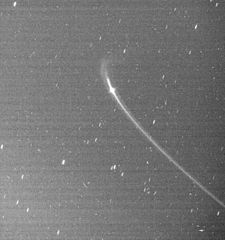Anthe (księżyc)
| ||
 Anthe i towarzyszący jej łuk materii (niekompletny pierścień) | ||
| Planeta | Saturn | |
| Odkrywca | Cassini Imaging Team | |
| Data odkrycia | 30 maja 2007 | |
| Tymczasowe oznaczenie | S/2007 S 4 | |
| Charakterystyka orbity | ||
| Półoś wielka | 196 888 km[1] | |
| Mimośród | 0,0011[1] | |
| Okres obiegu | 1,036 d[1] | |
| Nachylenie do płaszczyzny Laplace’a | 0,015°[1] | |
| Długość węzła wstępującego | 287,852°[1] | |
| Argument perycentrum | 138,902°[1] | |
| Anomalia średnia | 190,473°[1] | |
| Własności fizyczne | ||
| Średnica równikowa | 1,8 km[2] | |
| Okres obrotu wokół własnej osi | synchroniczny | |
| Jasność obserwowana (z Ziemi) | 26m | |
Anthe (Saturn XLIX) – niewielki księżyc Saturna, krążący w obszarze między orbitami Mimasa i Enceladusa. Został odkryty 30 maja 2007 na zdjęciach wykonanych przez sondę Cassini. Po odkryciu przeanalizowano wcześniejsze zdjęcia z sondy i okazało się, że księżyc widoczny był już na zdjęciach wykonanych w czerwcu 2004[2].
Nazwa pochodzi od Anthe – jednej z Alkyonid, siedmiu córek Alkyoneusa[2]. Zespół odkrywców używał wcześniej (nieformalnie) nazwy Frank.
Zobacz też
- Chronologiczny wykaz odkryć planet, planet karłowatych i ich księżyców w Układzie Słonecznym
- Księżyce Saturna
Przypisy
Linki zewnętrzne
- S/2007 S4. W: Księżyce Układu Słonecznego [on-line]. [dostęp 2015-10-01]. [zarchiwizowane z tego adresu (2014-07-22)].
- Wiadomość o odkryciu na stronie NASA (ang.)
Media użyte na tej stronie
This is a revised version of Solar_System_XXIX.png.
Original Caption Released with Image: Cassini images reveal the existence of a faint arc of material orbiting with Saturn's small moon Anthe.
The moon is moving downward and to the right in this perspective. In this image, most of the visible material in the arc lies ahead of Anthe (2 kilometers, or 1 mile across) in its orbit. However, over time the moon drifts slowly back and forth with respect to the arc. The arc extends over about 20 degrees in longitude (about 5.5 percent of Anthe's orbit) and appears to be associated with a gravitational resonance caused by the moon Mimas. Micrometeoroid impacts on Anthe are the likely source of the arc material. The orbit of Anthe lies between the larger moons Mimas and Enceladus. Anthe shares this region with two other small moons, Pallene (4 kilometers, or 3 miles across) and Methone (3 kilometers, or 2 miles across). Methone also possesses an arc (see PIA11102), while Pallene is known to orbit within a faint, complete ring of its own (see PIA08328).
Cassini imaging scientists believe the process that maintains the Anthe and Methone arcs is similar to that which maintains the arc in the G ring (see PIA08327). The general brightness of the image (along with the faint horizontal banding pattern) results from the long exposure time of 32 seconds required to capture the extremely faint ring arc and the processing needed to enhance its visibility (which also enhances the digital background noise in the image). The image was digitally processed to remove most of the background noise. The long exposure also produced star trails in the background. This view looks toward the un-illuminated side of the rings from about 3 degrees above the ringplane.
The image was taken in visible light with the Cassini spacecraft narrow-angle camera on July 3, 2008. The view was obtained at a distance of approximately 1.2 million kilometers (739,000 miles) from Anthe and at a sun-Anthe-spacecraft, or phase, angle of 12 degrees. Image scale is 7 kilometers (4 miles) per pixel.Saturn Cassini-Huygens (NASA)
Instrument: Imaging Science Subsystem - Narrow Angle
Saturn's peaceful beauty invites the Cassini spacecraft for a closer look in this natural color view, taken during the spacecraft's approach to the planet. By this point in the approach sequence, Saturn was large enough that two narrow angle camera images were required to capture an end-to-end view of the planet, its delicate rings and several of its icy moons. The composite is made entire from these two images.
Moons visible in this mosaic: Epimetheus (116 kilometers, 72 miles across), Pandora (84 kilometers, 52 miles across) and Mimas (398 kilometers, 247 miles across) at left of Saturn; Prometheus (102 kilometers, 63 miles across), Janus (181 kilometers, 113 miles across) and Enceladus (499 kilometers, 310 miles across) at right of Saturn.
The images were taken on May 7, 2004 from a distance of 28.2 million kilometers (17.6 million miles) from Saturn. The image scale is 169 kilometers (105 miles) per pixel. Moons in the image have been brightened for visibility.
The Cassini-Huygens mission is a cooperative project of NASA, the European Space Agency and the Italian Space Agency. The Jet Propulsion Laboratory, a division of the California Institute of Technology in Pasadena, manages the Cassini-Huygens mission for NASA's Office of Space Science, Washington, D.C. The Cassini orbiter and its two onboard cameras, were designed, developed and assembled at JPL. The imaging team is based at the Space Science Institute, Boulder, Colo.
For more information, about the Cassini-Huygens mission visit, http://saturn.jpl.nasa.gov and the Cassini imaging team home page, http://ciclops.org.Anthe (Saturn XLIX) - niewielki księżyc Saturna




